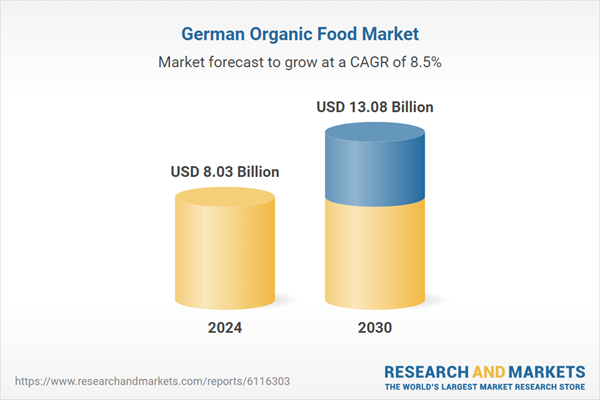Speak directly to the analyst to clarify any post sales queries you may have.
10% Free customizationThis report comes with 10% free customization, enabling you to add data that meets your specific business needs.
Key Market Drivers
Rising Health and Wellness Awareness
A major driver of Germany’s organic food market is the growing awareness of health and wellness among consumers. As people become increasingly conscious of the relationship between diet and health, there is a marked shift toward organic foods perceived as healthier and safer. Organic products are free from synthetic pesticides, chemical fertilizers, antibiotics, and genetically modified organisms (GMOs), which appeals to health-focused individuals. In Germany, where preventive healthcare and natural lifestyles are highly valued, consumers are prioritizing clean-label foods and seeking ingredients with minimal processing and artificial additives.This trend is particularly strong among young families, pregnant women, and individuals with allergies or sensitivities, who are willing to pay a premium for organic products that align with their dietary needs and values. According to a 2024 BMEL consumer survey, 76% of German consumers said health was the primary reason they buy organic products, highlighting the importance of perceived nutritional safety. Additionally, the COVID-19 pandemic further accelerated interest in healthy eating and immune-boosting diets, reinforcing the role of organic food in promoting long-term well-being.
Key Market Challenges
Price Sensitivity and Affordability Issues
One of the most significant challenges in the German organic food market is the high price of organic products compared to their conventional counterparts. Although many consumers in Germany are willing to pay a premium for quality and sustainability, economic constraints especially during times of inflation or financial uncertainty can limit their purchasing power. The price difference can be substantial for items like organic meat, dairy, and processed foods, making it difficult for lower-income households to include organic options in their regular grocery shopping.During periods of economic downturn or increased living costs, consumers may prioritize price over values such as health or sustainability, causing a shift back toward non-organic alternative. This price sensitivity creates a barrier to broader market penetration and poses a challenge to sustaining long-term growth, particularly among budget-conscious segments of the population. Moreover, the perception that organic products are luxury or niche items may further restrict their accessibility and appeal.
Key Market Trends
Growth of Plant-Based Organic Products
One of the most prominent trends in Germany’s organic food market is the rapid growth of plant-based organic products. Driven by a combination of ethical, health, and environmental concerns, more consumers are shifting toward vegetarian and vegan diets. Organic plant-based alternatives such as meat substitutes, dairy-free beverages, vegan snacks, and plant-based ready meals are gaining widespread popularity. These products not only cater to vegans and vegetarians but also to flexitarians who are reducing animal-based consumption for health and sustainability reasons.German consumers are particularly interested in clean-label products that avoid synthetic additives and are produced under environmentally responsible conditions. As a result, organic certifications add an extra layer of trust and appeal. Supermarkets and organic retailers are rapidly expanding their plant-based offerings to meet this demand, and innovation in product development is leading to new varieties and improved taste and texture. According to ProVeg Germany’s 2024 findings, more than 55% of German consumers identify as flexitarian, and organic plant-based meat sales grew by over 20% year-on-year, reflecting the intersection of organic principles with the booming plant-based movement and reinforcing the market’s overall growth trajectory.
Key Market Players
- Hipp GmbH & Co Vertrieb KG
- Alnatura Produktions- und Handels GmbH
- REWE Markt GmbH
- Aldi Einkauf GmbH & Co oHG
- Netto Marken-Discount AG & Co KG
- Lidl Stiftung & Co. KG
- Rapunzel Naturkost GmbH
- EDEKA Handelsgesellschaft Nord mbH
- Andechser Molkerei Scheitz GmbH
- Gepa - The Fair Trade Company
Report Scope:
In this report, the Germany Organic Food Market has been segmented into the following categories, in addition to the industry trends which have also been detailed below:Germany Organic Food Market, By Type:
- Fruits & Vegetables
- Dairy Products
- Meat, Fish & Poultry
- Others
Germany Organic Food Market, By Sales Channel:
- Supermarkets/Hypermarkets
- Convenience Stores
- Specialty Stores
- Online
- Others
Germany Organic Food Market, By Region:
- South-West
- North-West
- North-East
- South-East
Competitive Landscape
Company Profiles: Detailed analysis of the major companies present in the Germany Organic Food Market.Available Customizations:
With the given market data, the publisher offers customizations according to a company's specific needs. The following customization options are available for the report.Company Information
- Detailed analysis and profiling of additional market players (up to five).
This product will be delivered within 1-3 business days.
Table of Contents
Companies Mentioned
- Hipp GmbH & Co Vertrieb KG
- Alnatura Produktions- und Handels GmbH
- REWE Markt GmbH
- Aldi Einkauf GmbH & Co oHG
- Netto Marken-Discount AG & Co KG
- Lidl Stiftung & Co. KG
- Rapunzel Naturkost GmbH
- EDEKA Handelsgesellschaft Nord mbH
- Andechser Molkerei Scheitz GmbH
- Gepa - The Fair Trade Company
Table Information
| Report Attribute | Details |
|---|---|
| No. of Pages | 81 |
| Published | August 2025 |
| Forecast Period | 2024 - 2030 |
| Estimated Market Value ( USD | $ 8.03 Billion |
| Forecasted Market Value ( USD | $ 13.08 Billion |
| Compound Annual Growth Rate | 8.5% |
| Regions Covered | Germany |
| No. of Companies Mentioned | 10 |









